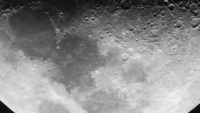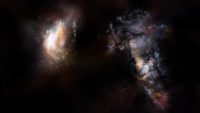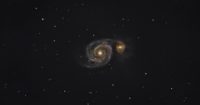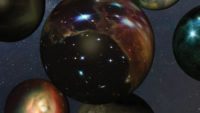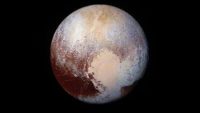By Dr. Danny R. Faulkner There are 5,000 known extrasolar planets, and they are a problem for evolution because they defy naturalistic origins. …read more Source: AIG Daily
Evidence from NASA’s Juno spacecraft suggests that Mars dust is the cause of the zodiacal lights, known since ancient times. …read more Source: creation.com
By Dr. Danny R. Faulkner Despite some similarities, Earth and the planet next door have very different purposes. …read more Source: AIG Daily
By Dr. Danny R. Faulkner Stellar evolutionists have aimed to solve the young faint sun paradox since Carl Sagan’s attempt a half-century ago, and the solution still eludes them. …read more Source: AIG Daily
By Dr. Danny R. Faulkner Two fundamental laws of physics clash if we try to explain the universe’s origin without a Creator. …read more Source: AIG Daily
By Dr. Jason Lisle The “big bang” story aims to explain the universe’s origin without God and simultaneously fails to align with either the Bible & established scientific findings. …read more Source: AIG Daily
By Ken Ham You may have seen the news reports a few weeks ago stating that humans have now “touched” the sun—well, this exciting NASA mission, featuring the Parker Solar Probe, did indeed “touch” the sun. The probe reached the sun’s atmosphere (the corona), nearly four million miles from the sun’s surface, in order to sample the particles and the magnetic field found there. And an Answers in Genesis (AiG) staff member was involved in this historic mission! Rob Webb started with AiG in November as our new apologetics and science writer (he’s already published on our website, with more [More]
By Ken Ham Just 325 light-years away from Earth is the Centaurus constellation, which hosts a binary (two-star) star system. An exoplanet is a planet outside of our solar system. The list of exoplanets continues to get longer and longer as research techniques and technologies allow us here on Earth to detect these far-flung worlds. Well, another exoplanet has recently been added to the list, this one 325 light-years away from Earth in the constellation Centaurus. This new planet orbits a star which is part of a binary (two-star) star system. And this newly discovered world is quite unique! Discovered [More]
By Ken Ham A recent popular science article asked the question, “how real is the multiverse?” This is the idea (popularized in recent movies and shows) that our universe is just one of many, and it’s “a natural prediction of the physical theories that define the beginning of the universe. Or it might not. It’s tough to say, as new research has shown.” So, again, when it comes to questions such as this, what you believe about the past matters! As the article I referenced states, Cosmologists largely believe that when our universe was extremely young — less than a [More]
By Rob Webb The expected benefits from the new NASA telescope, the naturalistic assumptions integrated into its mission, and the only way to make sense of scientific investigation: God. …read more Source: AIG Daily
By Dr. Danny R. Faulkner Why astronomers believe in an expanding universe, how the universe isn’t “expanding into” anything, and the reasons biblical creationists should be careful when arguing against the big bang …read more Source: AIG Daily
Are cratered planetary landscapes and moonscapes, and colliding galaxies, evidence against an Intelligent Designer? …read more Source: creation.com
By Dr. Danny R. Faulkner The big bang has been the dominant cosmogony for more than a half century, but the lithium measurements in the universe do not match the model. …read more Source: AIG Daily
There are countless interconnected, precise, and non-coincidental features of Earth that directly contribute to our planet’s ability to sustain life. One such phenomenon is that of Earth’s ultraviolet shield called the atmosphere. The atmosphere’s complex arrangement and seamlessly balanced, life-sustaining attributes distinctly indicate non-coincidental purpose and skillful crafting by a Designer who “is before all things… More… …read more Source: icr.org
By Spike Psarris Every year, the moon moves an inch or so farther away from earth. It may not seem like much, but that tiny movement puts a big limit on the moon’s age. …read more Source: AIG Daily
A recent article in Sky & Telescope magazine explains why secular theorists have difficulty agreeing on the ages of Saturn’s moons.1 In the process, the article provides a reminder that Saturn’s rings are young. It also presents possible evidence that some of Saturn’s moons are also young. Most important, it highlights the fact that (incorrect) secular origins stories spanning alleged histories of billion… More… …read more Source: icr.org
On June 7, 2021, NASA’s Juno spacecraft flew closer to Jupiter’s moon Ganymede than any spacecraft had ever before. Ganymede is the largest moon in the Solar System—a body larger than the planet Mercury. Its frozen surface holds interest as a distant water source. Analysts still ponder three unique features of Ganymede, one of which they’re now seeing for the first time. If reactions to youthful features on other bodies ou… More… …read more Source: icr.org
By Dr. Danny R. Faulkner Astronomers have detected water ~13 billion light-years away, which may be confirmation of biblical cosmology recorded in Genesis. …read more Source: AIG Daily
By Dr. Danny R. Faulkner How the first exoplanet outside our galaxy was discovered using a new technique to investigate deep space objects and what that means for life beyond the Milky Way …read more Source: AIG Daily
Has a planet really been discovered outside our galaxy? How could they find it? Could it support life? …read more Source: creation.com
By Ken Ham If a scientist writes an article suggesting God is the Creator of all things, he or she will not be published in any mainstream journal or science website. But the former chair of the astronomy department at Harvard University wrote an article suggesting our universe was designed, and he was published in Scientific American. Why? Because he suggested aliens created the universe! It’s certainly ok to propose fictional aliens creating the universe, but not God! Avi Loeb begins his article by stating, “the biggest mystery concerning the history of our universe is what happened before the big [More]
By Dr. Danny R. Faulkner Why Pluto’s atmosphere changes between perihelion and aphelion in its 248-year orbit around the sun and what that means for the age of the dwarf planet …read more Source: AIG Daily
Is the big bang compatible with God’s creation described in Genesis? …read more Source: creation.com
By Dr. Danny R. Faulkner We at Answers in Genesis have always maintained that the big bang model is incompatible with Scripture. …read more Source: AIG Daily
By Ken Ham Second millennium BC asteroid impact in the Dead Sea region does not closely align with the ancient cities’ locations in Genesis. …read more Source: AIG Daily
The Antikythera Mechanism has proven to be an astonishingly complex mechanical computer capable of predicting the planets positions contradicting evolutionary ideas of primitive ancient man …read more Source: creation.com
























